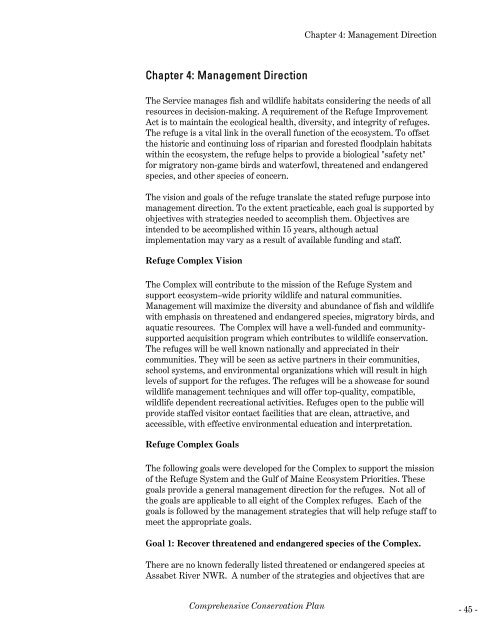Assabet River NWR Final CCP - U.S. Fish and Wildlife Service
Assabet River NWR Final CCP - U.S. Fish and Wildlife Service
Assabet River NWR Final CCP - U.S. Fish and Wildlife Service
Create successful ePaper yourself
Turn your PDF publications into a flip-book with our unique Google optimized e-Paper software.
Chapter 4: Management Direction<br />
Chapter 4: Management Direction<br />
The <strong>Service</strong> manages fish <strong>and</strong> wildlife habitats considering the needs of all<br />
resources in decision-making. A requirement of the Refuge Improvement<br />
Act is to maintain the ecological health, diversity, <strong>and</strong> integrity of refuges.<br />
The refuge is a vital link in the overall function of the ecosystem. To offset<br />
the historic <strong>and</strong> continuing loss of riparian <strong>and</strong> forested floodplain habitats<br />
within the ecosystem, the refuge helps to provide a biological "safety net"<br />
for migratory non-game birds <strong>and</strong> waterfowl, threatened <strong>and</strong> endangered<br />
species, <strong>and</strong> other species of concern.<br />
The vision <strong>and</strong> goals of the refuge translate the stated refuge purpose into<br />
management direction. To the extent practicable, each goal is supported by<br />
objectives with strategies needed to accomplish them. Objectives are<br />
intended to be accomplished within 15 years, although actual<br />
implementation may vary as a result of available funding <strong>and</strong> staff.<br />
Refuge Complex Vision<br />
The Complex will contribute to the mission of the Refuge System <strong>and</strong><br />
support ecosystem–wide priority wildlife <strong>and</strong> natural communities.<br />
Management will maximize the diversity <strong>and</strong> abundance of fish <strong>and</strong> wildlife<br />
with emphasis on threatened <strong>and</strong> endangered species, migratory birds, <strong>and</strong><br />
aquatic resources. The Complex will have a well-funded <strong>and</strong> communitysupported<br />
acquisition program which contributes to wildlife conservation.<br />
The refuges will be well known nationally <strong>and</strong> appreciated in their<br />
communities. They will be seen as active partners in their communities,<br />
school systems, <strong>and</strong> environmental organizations which will result in high<br />
levels of support for the refuges. The refuges will be a showcase for sound<br />
wildlife management techniques <strong>and</strong> will offer top-quality, compatible,<br />
wildlife dependent recreational activities. Refuges open to the public will<br />
provide staffed visitor contact facilities that are clean, attractive, <strong>and</strong><br />
accessible, with effective environmental education <strong>and</strong> interpretation.<br />
Refuge Complex Goals<br />
The following goals were developed for the Complex to support the mission<br />
of the Refuge System <strong>and</strong> the Gulf of Maine Ecosystem Priorities. These<br />
goals provide a general management direction for the refuges. Not all of<br />
the goals are applicable to all eight of the Complex refuges. Each of the<br />
goals is followed by the management strategies that will help refuge staff to<br />
meet the appropriate goals.<br />
Goal 1: Recover threatened <strong>and</strong> endangered species of the Complex.<br />
There are no known federally listed threatened or endangered species at<br />
<strong>Assabet</strong> <strong>River</strong> <strong>NWR</strong>. A number of the strategies <strong>and</strong> objectives that are<br />
Comprehensive Conservation Plan - 45 -

















